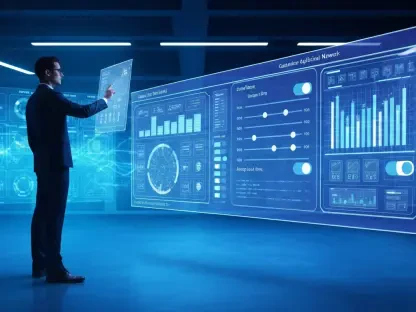Large Language Models (LLMs) represent a major revolution in artificial intelligence, altering the landscape of AI by enhancing the ability of machines to understand and generate human language. As these advanced systems evolve, they push the boundaries of what AI can achieve, with their influence spanning diverse sectors including healthcare, education, and customer service. This article explores the transformative journey of LLMs, examining their architecture, varied applications, and the challenges they face, while also speculating on potential future advancements.
Understanding Large Language Models
LLMs are immense AI systems designed to process natural language tasks by training on vast datasets. Unlike traditional rule-based systems that require explicit programming, LLMs learn linguistic patterns directly from the data, enabling them to perform sophisticated tasks like generating coherent text, answering complex queries, and even engaging in creative tasks like storytelling. Models such as GPT-4 and BERT are prime examples, showcasing the power of billions of parameters to understand and manipulate language with high precision.
Key characteristics define LLMs: they include billions of parameters, making them computationally demanding yet highly capable. They draw from extensive and diverse training data, including books, websites, and social media content, capturing a wide range of linguistic patterns. These models demonstrate an impressive ability to generalize across various tasks without needing special training for each individual task—a feature known as “zero-shot” or “few-shot” learning. Additionally, LLMs maintain contextual awareness over long sequences, enabling coherent conversation and comprehensive document analysis.
Evolution of LLMs
The path to contemporary LLMs has been marked by significant milestones in model size, architectural advancements, and training methodologies. Initially, natural language processing (NLP) systems relied on rule-based approaches and statistical models like n-grams, which often faced challenges related to maintaining context and scalability. The introduction of word embeddings such as Word2Vec in the 2010s represented a crucial step forward, allowing models to capture semantic relationships between words more effectively.
The significant breakthrough came with the introduction of the Transformer architecture, detailed in the 2017 paper “Attention is All You Need.” Transformer’s self-attention mechanisms allow for efficient processing of long sequences by focusing on the importance of different words in a text, marking a revolutionary step in NLP. Leveraging this architecture, models such as BERT and GPT set new performance benchmarks for tasks including text classification and generation. The most recent advancements in model sizes, exemplified by models like GPT-3, with its 175 billion parameters, further showcase the exponential improvements in zero-shot learning capabilities.
Architecture and Functioning of LLMs
The architecture of LLMs primarily revolves around the Transformer model, which comprises several essential components that contribute to its effectiveness. These components include the encoder, which processes input text to create contextual representations; the decoder, which generates output text based on input or previous tokens; and the attention mechanism, which assigns weights to different words in a sequence, enhancing context-aware processing. Additionally, feedforward layers transform the data through dense neural networks, and positional encoding adds information about the sequence’s order.
The process of training LLMs involves two main stages: pretraining and fine-tuning. During pretraining, the model is exposed to extensive text corpora to learn general language patterns, using techniques like autoregressive training to predict the next word in a sequence, or masked language modeling to fill in missing words. In the fine-tuning stage, the model is further refined on task-specific datasets to improve performance for particular applications. Technological advancements such as Reinforcement Learning from Human Feedback (RLHF) align models with user preferences, enhancing their functionality.
Inference is the final phase, where LLMs generate text by sampling from probability distributions over their vocabulary. Techniques like beam search and temperature scaling are employed during this phase to ensure the generated text is both creative and coherent, making the output suitable for a wide range of practical applications.
Applications of LLMs
LLMs have demonstrated extraordinary versatility, with their potential applications spanning a multitude of industries. In the realm of conversational AI, they are pivotal in powering chatbots such as Grok and ChatGPT. These chatbots manage customer service queries, provide personalized recommendations, and maintain dialogue context in virtual assistants and interactive learning platforms. This capability enhances user experience by delivering more natural and effective interactions, significantly improving customer satisfaction.
In content generation, tools like Jasper and Copy.ai harness the power of LLMs to create diverse forms of text, including articles, marketing copy, and creative writing pieces. These tools support content creators by generating drafts, brainstorming ideas, and even optimizing content for specific audiences. This has revolutionized the way content is produced, enabling faster and more efficient content creation processes.
Translation services like Google Translate and DeepL also benefit from LLMs, as these models offer nuanced and context-aware translations that preserve cultural relevance. This ensures that the translated content remains accurate and meaningful, fostering better communication across languages and cultures.
In the field of software development, LLMs like Codex and GitHub Copilot assist developers by generating code snippets, debugging, and providing optimization suggestions in various programming languages. This not only accelerates the development process but also reduces the likelihood of errors, leading to more robust and efficient software solutions.
Additionally, LLMs play a significant role in education by personalizing learning experiences. They generate custom study materials, answer student questions, and can even assist in grading assignments. Educational platforms like Duolingo leverage LLMs to enhance language learning, making the process more interactive and engaging for users.
Challenges and Limitations
Despite the transformative potential of LLMs, they are not without challenges. One significant issue is the inherent bias that these models might inherit from their training data. This bias can result in prejudiced outputs, such as reinforcing gender stereotypes or racial biases. Addressing these biases requires meticulous data curation and algorithmic interventions to ensure more equitable and fair model behavior.
The computational costs associated with training and deploying LLMs are another substantial limitation. Training large models can cost millions of dollars and consume a vast amount of energy, making it an environmentally and economically demanding process. Additionally, running these models in real-time requires high-performance hardware, limiting access for smaller organizations and individuals.
LLMs also face the problem of hallucination, where they generate plausible-sounding but incorrect or misleading information. This is especially concerning in critical applications such as legal advice or medical diagnostics, where accuracy is paramount. Developing mechanisms to detect and mitigate hallucinations is crucial for ensuring the reliability of LLM outputs in such high-stakes scenarios.
Ethical concerns around the misuse of LLMs also persist. The ability of these models to generate convincing deepfake text or misinformation poses a significant risk. Ensuring responsible deployment and use, with robust guidelines and governance, is essential to prevent potential misuse and maintain public trust.
One of the more technical challenges is the interpretability of LLMs. Often viewed as “black boxes,” their decision-making processes are not easily understood, making it difficult for users to trust and hold them accountable. Enhancing the interpretability of these models is vital for fostering transparency and reliability in their applications.
Future Directions
The future of LLMs is promising, with several exciting developments on the horizon aimed at addressing current challenges and expanding their capabilities. Efficiency improvements through techniques like model pruning, distillation, and optimized attention mechanisms are expected to reduce computational costs, making these advanced models more accessible to a broader range of users.
The development of multimodal models that can process various types of data, including text, images, and audio, is another anticipated advancement. Models like DALL-E and CLIP integrate text with visual understanding, paving the way for richer and more diverse application possibilities. This evolution will enable more comprehensive and contextually aware AI systems capable of understanding and interacting with the world in more human-like ways.
Domain-specific LLMs tailored for specialized fields such as law, medicine, or finance are likely to improve accuracy and relevance by being trained on domain-specific data. These specialized models will offer significant advantages in their respective areas, providing more precise and useful outputs tailored to specific professional needs.
Ethical AI continues to be a crucial area of focus, with ongoing efforts aimed at mitigating bias, enhancing transparency, and establishing robust governance frameworks. Progress in these areas will address ethical concerns, build public trust, and ensure responsible AI development and deployment.
Integrating LLMs with real-world systems, such as robotics, the Internet of Things (IoT), and augmented reality, is another anticipated trend. This integration will facilitate seamless human-machine interactions in physical environments, enabling more intuitive and efficient collaboration between humans and intelligent systems.
Harnessing Potential
Large Language Models (LLMs) signify a monumental shift in the realm of artificial intelligence, fundamentally reshaping the way machines comprehend and generate human language. These sophisticated systems have progressively evolved, pushing the limits of AI capabilities. They exert a significant influence across various sectors, including healthcare, education, and customer service, illustrating their wide-reaching potential. This article delves deep into the transformative journey of LLMs, shedding light on their intricate architecture, diverse applications, and the numerous challenges they encounter. It also speculates on future advancements that might further enhance these models. From diagnosing diseases more accurately to offering personalized educational experiences and improving customer interactions, LLMs are paving the way for new possibilities. However, their development is not without obstacles such as ethical concerns, data privacy issues, and the need for massive computational resources. As we look to the future, the continued evolution and integration of LLMs promise to bring about unprecedented changes, establishing new standards in AI performance and application.









